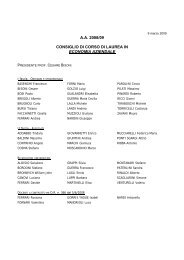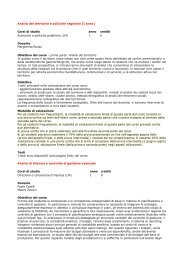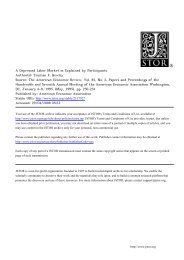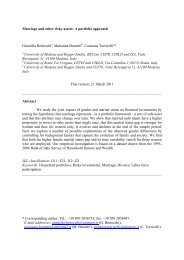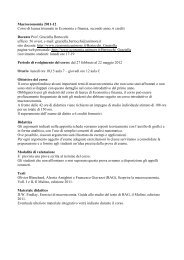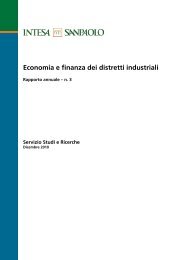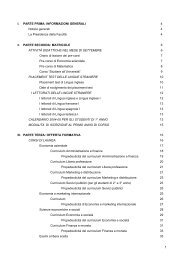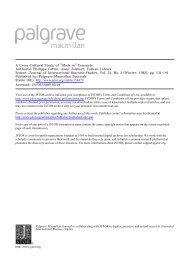Create successful ePaper yourself
Turn your PDF publications into a flip-book with our unique Google optimized e-Paper software.
mark<strong>et</strong>ing mix – “extern<strong>al</strong> product/features”, “intern<strong>al</strong> product/technology”, “productqu<strong>al</strong>ity aspects”, “pricing considerations”, “distribution/service”, and “promotion<strong>al</strong>issues” – with each group containing four items (see Table III). To establish thereliability and v<strong>al</strong>idity of the sc<strong>al</strong>es constructed, confirmatory factor an<strong>al</strong>ysis, usingthe EQS program, was undertaken (see Table IV). Both the likelihood Chi-squarestatistic and the <strong>al</strong>ternative fit indices reve<strong>al</strong>ed v<strong>al</strong>ues within the commonly acceptedcritic<strong>al</strong> levels. Construct reliability was acceptable, because the Cronbah’s <strong>al</strong>phacoefficients estimated for each construct exceeded .80 (Nunn<strong>al</strong>ly and Bernstein, 1994).Convergent v<strong>al</strong>idity was <strong>al</strong>so satisfactory, because the factor loadings for <strong>al</strong>l itemscomprising each construct exceeded 0.75, while the t-v<strong>al</strong>ue for each item was greaterthan 15.0 (Bagozzi and Yi, 1988).US versusChinese goods803An<strong>al</strong>ysis and discussionThis section an<strong>al</strong>yzes and discusses the results with regard to each of the threeresearch hypotheses. In order to carry out the statistic<strong>al</strong> an<strong>al</strong>ysis, compound scores foreach of the six groups of product cues were c<strong>al</strong>culated, based on the average of theitems contained in each group. Differences among the means of consumer ev<strong>al</strong>uationsat the five levels of an<strong>al</strong>ysis, as well as among the six categories of product cues, wereconducted using the ANOVA test, while to trace the source of potenti<strong>al</strong> differences, theScheffé’s test was employed (at a ¼ 0:05). Fin<strong>al</strong>ly, comparisons of British consumers’ev<strong>al</strong>uations of US versus Chinese goods were tested using the student-t formatched-paired samples[9].Testing hypotheses H1a and H1bBritish consumer perceptions of goods made in the USA exhibited statistic<strong>al</strong>lysignificant variations across <strong>al</strong>l five levels of an<strong>al</strong>ysis (see Table V – upper part). Thiswas true for each of the six groups of product cues, namely extern<strong>al</strong> product/features,intern<strong>al</strong>/product technology, product qu<strong>al</strong>ity aspects, pricing considerations,distribution/service, and promotion<strong>al</strong> issues (<strong>al</strong>l p’s , 0.01). The source of thesedifferences was mainly linked to the Whirpool brand, which was ev<strong>al</strong>uated morefavorably by respondents compared to the country as a whole, its electric<strong>al</strong> appliancesindustry, and the refrigerators produced by US manufacturers. However, when aphotograph of the specific Whirpool model was shown to respondents, theirev<strong>al</strong>uations became less positive again compared to those expressed earlier for thebrand. Interestingly, there were no serious differences in consumer ev<strong>al</strong>uations at thecountry, industry, and product level, indicating that consumers do not benefit from anyfurther information at a more specific level of an<strong>al</strong>ysis that would help them to havemore precise knowledge.A similar pattern was <strong>al</strong>so observed in the case of British consumer ev<strong>al</strong>uations ofChinese goods: there were only slight variations in their perceptions among country,industry, and product levels, for <strong>al</strong>l categories of product cues (see Table V – lowerpart). However, when the Haier brand was reve<strong>al</strong>ed to consumers, their ev<strong>al</strong>uationsseriously d<strong>et</strong>eriorated, recording statistic<strong>al</strong>ly significant differences when comparedwith perceptions of China as a whole, electric<strong>al</strong> appliances, and refrigerators (<strong>al</strong>lps # 0.01). Surprisingly, when the photograph and more hands-on information aboutthe specific Haier model were disclosed, consumer ev<strong>al</strong>uations became more favorableagain. This can be attributed to the fact that consumers had at their dispos<strong>al</strong> more




